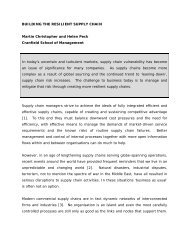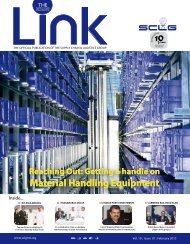Free to Download - SCLG
Free to Download - SCLG
Free to Download - SCLG
- TAGS
- download
- sclg
- sclgme.org
You also want an ePaper? Increase the reach of your titles
YUMPU automatically turns print PDFs into web optimized ePapers that Google loves.
IRELAND SPECIAL Information Technology<br />
The Utilization of Information<br />
Technology for Supply Chain<br />
Management in Ireland<br />
The traditional concern of supply chain management<br />
has been the movement of materials from original<br />
source <strong>to</strong> the point of final consumption.<br />
The traditional concern of supply chain<br />
management has been the movement<br />
of materials from original source <strong>to</strong><br />
the point of final consumption. In addition <strong>to</strong><br />
the downstream flow of materials, modern<br />
supply chain management is also concerned<br />
with other flows such as the upstream flow<br />
of reverse logistics and the flow of funds<br />
through the supply chain. Supply chain<br />
management seeks <strong>to</strong> carry out supply<br />
chain activities in an efficient and effective<br />
manner. In order <strong>to</strong> do so, organisations<br />
must recognise the need <strong>to</strong> streamline not<br />
only their internal processes but also the<br />
20 Link January 2011<br />
processes that link <strong>to</strong> their trading partners.<br />
Collaboration among supply chain<br />
partners enables the supply chain <strong>to</strong> better<br />
meet the needs of the final cus<strong>to</strong>mer.<br />
Collaborative practices act <strong>to</strong> make the<br />
supply chain more competitive by reducing<br />
costs and adding extra value thereby<br />
increasing the profitability of the supply chain<br />
participants. Collaboration is seen in practice<br />
in a number of approaches <strong>to</strong> supply chain<br />
management. Vendor managed inven<strong>to</strong>ry<br />
(VMI), collaborative planning forecasting<br />
and replenishment (CPFR) just-in-time (JIT)<br />
and efficient cus<strong>to</strong>mer response (ECR) are<br />
Liam Doyle<br />
some of approaches <strong>to</strong> collaboration that<br />
have brought benefits <strong>to</strong> supply chains in a<br />
number of industries. There has also been<br />
an increasing awareness of the need <strong>to</strong><br />
adopt an appropriate approach <strong>to</strong> supply<br />
chain strategy. Companies have adopted<br />
lean or agile approaches, or an appropriate<br />
combination of both, <strong>to</strong> support their supply<br />
chain strategy. In many cases companies<br />
have moved from the traditional push based<br />
model, where goods are produced in the<br />
hope the hope that demand will arise, <strong>to</strong> the<br />
pull based model where goods are produced<br />
in response <strong>to</strong> demand.<br />
Regardless of the supply chain strategy<br />
adopted or the supply chain practices<br />
employed, the efficient and effective<br />
operation of supply chains requires the<br />
sharing of information. Pull based models<br />
require the sharing of demand information<br />
among supply chain participants. Push<br />
based models require the sharing of<br />
forecasts. Collaborative approaches require<br />
information such as demand and s<strong>to</strong>ck<br />
levels <strong>to</strong> be shared.<br />
The requirement for sharing of<br />
information requires the flow of information

















